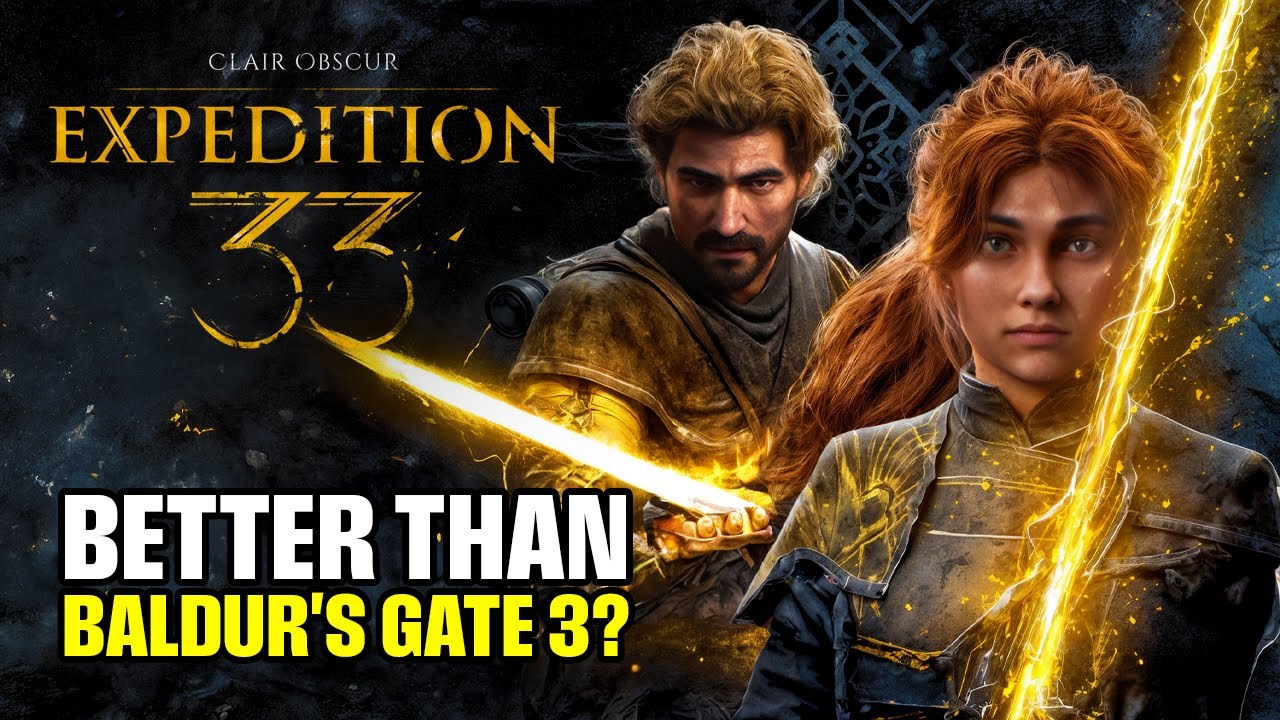🎨 A NEW RPG KING HAS RISEN! 🎨
What if a French masterpiece stole the crown from the RPG titan of 2023? A breathtaking world, heart-wrenching tales, and battles that pulse with style—Clair Obscur: Expedition 33 is turning heads and breaking hearts in 2025. Could it outshine Baldur’s Gate 3? 🤔 Dive into a story that’s as haunting as it is beautiful and uncover why gamers can’t stop talking about it!
Click below to explore the magic! 🔗

In 2023, Baldur’s Gate 3 redefined role-playing games, earning Game of the Year honors with its sprawling, choice-driven epic rooted in Dungeons & Dragons. Fast forward to 2025, and a new contender has emerged: Clair Obscur: Expedition 33, a French RPG from Sandfall Interactive that’s taken the gaming world by storm. With a 92/100 Metacritic score, over 1 million copies sold in three days, and praise from industry veterans like David Gaider, Clair Obscur is being hailed as a potential “JRPG Baldur’s Gate 3.” But does it truly surpass Larian Studios’ masterpiece? This article explores why Clair Obscur: Expedition 33 might be considered better than Baldur’s Gate 3 in 2025, examining their combat, narratives, accessibility, and cultural impact.
The Rise of Clair Obscur: Expedition 33
Clair Obscur: Expedition 33, developed by a small French studio with under 50 employees, is a turn-based RPG with real-time mechanics, set in a Belle Époque-inspired world. Players guide Expedition 33, led by characters like Gustave and Maelle (voiced by Jennifer English, Baldur’s Gate 3’s Shadowheart), on a quest to defeat the Paintress, a godlike entity who marks people for death annually. The game’s 35-hour campaign blends haunting storytelling, French Baroque visuals, and a combat system that fuses Persona-like flair with Soulslike dodging and parrying. Its critical acclaim, including a rare 10/10 from Edge Magazine, and commercial success—projected to hit 8–10 million sales—signal a new benchmark for JRPGs.
Baldur’s Gate 3: The CRPG Titan
Baldur’s Gate 3, released by Larian Studios in 2023, is a CRPG masterpiece built on D&D 5e rules. Its 100+ hour campaign offers unparalleled player freedom, from crafting custom protagonists to romancing companions like Shadowheart and Karlach. The game’s tactical, turn-based combat rewards strategic positioning and environmental manipulation, while its branching narrative adapts to player choices. With robust modding support and post-launch updates like Patch 8, it remains a fan favorite, credited with reviving the CRPG genre. However, its complexity and length can overwhelm newcomers, and Act 3’s pacing has drawn criticism.
Combat: Innovation vs. Tradition
Combat is a key battleground in this comparison. Baldur’s Gate 3’s turn-based system, rooted in D&D, emphasizes initiative rolls, spell slots, and environmental tactics. Players must master complex mechanics, like line-of-sight positioning or crowd-control spells, to succeed. This depth appeals to CR Diversity and inclusion: CRPG fans but can feel daunting for casual players. The system shines in allowing creative strategies, such as shoving enemies off cliffs or combining spells for devastating effects, but requires significant time investment to master.
Clair Obscur takes a different approach, blending turn-based combat with real-time elements like dodging, parrying, and quick-time events. This hybrid system, inspired by Persona and Sekiro, keeps battles fast-paced and engaging, with a focus on timing and synergy between party members’ skills. The Pictos system, which grants stat boosts and perks, adds depth without overwhelming players. Critics praise its accessibility and polish, noting that it avoids the “slow and clunky” stereotype of turn-based RPGs. For players who find Baldur’s Gate 3’s combat too cerebral, Clair Obscur’s dynamic, stylish battles feel refreshing and intuitive.
Why Clair Obscur Wins: Clair Obscur’s combat is more approachable, requiring less rules knowledge while maintaining strategic depth. Its real-time mechanics add excitement, making every encounter feel like a dance of reflexes and tactics, potentially appealing to a broader audience than Baldur’s Gate 3’s niche CRPG mechanics.
Narrative: Focused Emotion vs. Sprawling Freedom
Baldur’s Gate 3’s narrative is a sprawling epic, offering players freedom to shape their story through moral choices, companion relationships, and world-altering decisions. Its cast, including Astarion and Gale, is beloved for their depth and romance options, but the game’s 100+ hour length can dilute its pacing, especially in Act 3, where side quests sometimes overshadow the main plot. The story’s philosophical themes, like confronting control through the final boss (a massive brain symbolizing hubris), resonate deeply but require commitment.
Clair Obscur opts for a leaner, 35-hour story, delivering a tightly paced narrative with no filler. Set in the fractured city of Lumiere, it follows Expedition 33’s desperate quest against the Paintress, a symbolic figure of fatalism and artistry. The game balances heart-wrenching moments with lighthearted camp interactions, creating emotional variety that critics, including David Gaider, praise as masterful. Characters like Maelle and Verso shine through intimate dialogue and stellar voice acting, rivaling Baldur’s Gate 3’s companions in impact.
Why Clair Obscur Wins: Clair Obscur’s concise, emotionally charged story avoids the bloat that can disrupt Baldur’s Gate 3’s momentum. Its linear focus ensures every moment advances the plot, delivering a cohesive experience that resonates without requiring a massive time investment.
Art and Atmosphere: French Flair vs. Fantasy Epic
Clair Obscur’s Belle Époque-inspired visuals, with their painterly, melancholic beauty, create a unique aesthetic distinct from Baldur’s Gate 3’s high-fantasy world of Faerûn. Its haunting soundtrack and isometric overworld evoke classic JRPGs like Final Fantasy, while its camp, shrouded in perpetual darkness, adds emotional weight to character interactions. The game’s art direction and music are universally praised, making every scene a visual and auditory treat.
Baldur’s Gate 3’s world is immersive, with detailed environments like Baldur’s Gate city and the Underdark. Its visuals, while stunning for a CRPG, lean on traditional fantasy tropes—castles, forests, and dungeons. The game’s soundtrack is epic but less distinctive than Clair Obscur’s evocative score. The sheer scale of Baldur’s Gate 3’s world can overwhelm, with side content sometimes distracting from the main quest.
Why Clair Obscur Wins: Clair Obscur’s unique French Baroque style and cohesive atmosphere outshine Baldur’s Gate 3’s more conventional fantasy aesthetic. Its shorter length ensures a consistent tone, making every visual and musical moment feel purposeful.
Accessibility and Cultural Impact
Clair Obscur’s accessibility is a major strength. Its 35-hour runtime and streamlined mechanics make it welcoming to newcomers, while its availability on Game Pass, PlayStation 5, Xbox Series X/S, and PC broadens its reach. Selling over 1 million copies in three days and projected to hit 8–10 million, it’s a commercial juggernaut. Industry figures like Swen Vincke and David Gaider laud its polish and potential to expand the JRPG audience, much like Baldur’s Gate 3 did for CRPGs.
Baldur’s Gate 3 appeals to CRPG enthusiasts with its D&D roots and modding community, but its complexity and length can deter casual players. Its success (50 million potential audience, per Larian’s Michael Douse) revitalized CRPGs, but its niche mechanics limit its universal appeal compared to Clair Obscur’s broader accessibility.
Why Clair Obscur Wins: Clair Obscur’s shorter length, intuitive combat, and Game Pass availability make it more accessible than Baldur’s Gate 3. Its ability to attract non-JRPG fans mirrors Baldur’s Gate 3’s genre expansion but reaches a wider audience with less commitment.
Challenges and Counterarguments
Clair Obscur isn’t perfect. Its linear narrative lacks Baldur’s Gate 3’s replayability, as players can’t shape the story or create custom characters. Its modding potential is limited, unlike Baldur’s Gate 3’s thriving modding scene, which even includes Clair Obscur character heads. Some fans argue that Baldur’s Gate 3’s depth, freedom, and long-term support make it the superior RPG for dedicated players.
Baldur’s Gate 3’s customization and sandbox elements allow for near-infinite playstyles, from heroic paladins to villainous rogues. Its environmental combat and companion romances create personal stories that Clair Obscur’s fixed cast intravelerse perspective, Clair Obscur can feel restrictive to players who crave such freedom. However, Clair Obscur’s focus and accessibility may appeal more to those seeking a concise, polished experience.
Conclusion
In 2025, Clair Obscur: Expedition 33 stands as a formidable rival to Baldur’s Gate 3. Its innovative combat, focused narrative, stunning French-inspired visuals, and broad accessibility give it an edge in delivering a concise, emotionally resonant experience. While Baldur’s Gate 3 excels in depth and freedom, its complexity and length can be daunting, and its sprawling story sometimes loses momentum. Clair Obscur’s streamlined design, dynamic battles, and universal appeal position it as a potential new king of RPGs, capable of reaching players beyond the JRPG niche. As the gaming world evolves, Clair Obscur’s success suggests it may redefine the genre, just as Baldur’s Gate 3 did for CRPGs. Whether it’s truly “better” depends on player preference, but its meteoric rise in 2025 proves it’s a masterpiece in its own right.





